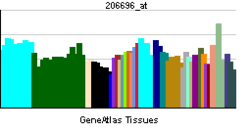GPR143
| View/Edit Human | View/Edit Mouse |
| Ocular albinism type 1 protein | |||||||||
|---|---|---|---|---|---|---|---|---|---|
| Identifiers | |||||||||
| Symbol | Ocular_alb | ||||||||
| Pfam | PF02101 | ||||||||
| Pfam clan | CL0192 | ||||||||
| InterPro | IPR001414 | ||||||||
| |||||||||
G-protein coupled receptor 143 is a protein encoded by the GPR143 gene in humans.[4][5][6]
Ocular albinism type 1 protein is a conserved integral membrane protein with seven transmembrane domains. It is expressed in the eye and epidermal melanocytes.[6]
The GPR143 gene is regulated by the Microphthalmia-associated transcription factor.[7][8]
L-DOPA is an endogenous ligand for OA1.[9]
Interactions
GPR143 has been shown to interact with GNAI1.[5]
References
- ↑ "Drugs that physically interact with G-protein coupled receptor 143 view/edit references on wikidata".
- ↑ "Human PubMed Reference:".
- ↑ "Mouse PubMed Reference:".
- ↑ Bassi MT, Schiaffino MV, Renieri A, De Nigris F, Galli L, Bruttini M, Gebbia M, Bergen AA, Lewis RA, Ballabio A (Sep 1995). "Cloning of the gene for ocular albinism type 1 from the distal short arm of the X chromosome". Nat Genet. 10 (1): 13–9. doi:10.1038/ng0595-13. PMID 7647783.
- 1 2 Schiaffino MV, d'Addio M, Alloni A, Baschirotto C, Valetti C, Cortese K, Puri C, Bassi MT, Colla C, De Luca M, Tacchetti C, Ballabio A (Sep 1999). "Ocular albinism: evidence for a defect in an intracellular signal transduction system". Nat Genet. 23 (1): 108–12. doi:10.1038/12715. PMID 10471510.
- 1 2 "Entrez Gene: GPR143 G protein-coupled receptor 143".
- ↑ Vetrini F, Auricchio A, Du J, et al. (2004). "The microphthalmia transcription factor (Mitf) controls expression of the ocular albinism type 1 gene: link between melanin synthesis and melanosome biogenesis". Mol. Cell. Biol. 24 (15): 6550–9. doi:10.1128/MCB.24.15.6550-6559.2004. PMC 444869
 . PMID 15254223.
. PMID 15254223. - ↑ Hoek KS, Schlegel NC, Eichhoff OM, et al. (2008). "Novel MITF targets identified using a two-step DNA microarray strategy". Pigment Cell Melanoma Res. 21 (6): 665–76. doi:10.1111/j.1755-148X.2008.00505.x. PMID 19067971.
- ↑ Lopez VM, Decatur CL, Stamer WD, Lynch RM, McKay BS (September 2008). Barsh GS, ed. "L-DOPA is an endogenous ligand for OA1". PLoS Biol. 6 (9): e236. doi:10.1371/journal.pbio.0060236. PMC 2553842
 . PMID 18828673.
. PMID 18828673.
Further reading
- Oetting WS, King RA (1999). "Molecular basis of albinism: mutations and polymorphisms of pigmentation genes associated with albinism.". Hum. Mutat. 13 (2): 99–115. doi:10.1002/(SICI)1098-1004(1999)13:2<99::AID-HUMU2>3.0.CO;2-C. PMID 10094567.
- Oetting WS (2002). "New insights into ocular albinism type 1 (OA1): Mutations and polymorphisms of the OA1 gene.". Hum. Mutat. 19 (2): 85–92. doi:10.1002/humu.10034. PMID 11793467.
- Schnur RE, Trask BJ, van den Engh G, et al. (1989). "An Xp22 microdeletion associated with ocular albinism and ichthyosis: approximation of breakpoints and estimation of deletion size by using cloned DNA probes and flow cytometry.". Am. J. Hum. Genet. 45 (5): 706–20. PMC 1683435
 . PMID 2573275.
. PMID 2573275. - Meindl A, Hosenfeld D, Brückl W, et al. (1993). "Analysis of a terminal Xp22.3 deletion in a patient with six monogenic disorders: implications for the mapping of X linked ocular albinism.". J. Med. Genet. 30 (10): 838–42. doi:10.1136/jmg.30.10.838. PMC 1016566
 . PMID 8230160.
. PMID 8230160. - Schiaffino MV, Bassi MT, Galli L, et al. (1996). "Analysis of the OA1 gene reveals mutations in only one-third of patients with X-linked ocular albinism.". Hum. Mol. Genet. 4 (12): 2319–25. doi:10.1093/hmg/4.12.2319. PMID 8634705.
- Schnur RE, Gao M, Wick PA, et al. (1998). "OA1 mutations and deletions in X-linked ocular albinism.". Am. J. Hum. Genet. 62 (4): 800–9. doi:10.1086/301776. PMC 1377018
 . PMID 9529334.
. PMID 9529334. - Rosenberg T, Schwartz M (1999). "X-linked ocular albinism: prevalence and mutations--a national study.". Eur. J. Hum. Genet. 6 (6): 570–7. doi:10.1038/sj.ejhg.5200226. PMID 9887374.
- d'Addio M, Pizzigoni A, Bassi MT, et al. (2001). "Defective intracellular transport and processing of OA1 is a major cause of ocular albinism type 1.". Hum. Mol. Genet. 9 (20): 3011–8. doi:10.1093/hmg/9.20.3011. PMID 11115845.
- Bassi MT, Bergen AA, Bitoun P, et al. (2001). "Diverse prevalence of large deletions within the OA1 gene in ocular albinism type 1 patients from Europe and North America.". Hum. Genet. 108 (1): 51–4. doi:10.1007/s004390000440. PMID 11214907.
- Strausberg RL, Feingold EA, Grouse LH, et al. (2003). "Generation and initial analysis of more than 15,000 full-length human and mouse cDNA sequences.". Proc. Natl. Acad. Sci. U.S.A. 99 (26): 16899–903. doi:10.1073/pnas.242603899. PMC 139241
 . PMID 12477932.
. PMID 12477932. - Touloukian CE, Leitner WW, Schnur RE, et al. (2003). "Normal tissue depresses while tumor tissue enhances human T cell responses in vivo to a novel self/tumor melanoma antigen, OA1.". J. Immunol. 170 (3): 1579–85. doi:10.4049/jimmunol.170.3.1579. PMC 2241741
 . PMID 12538723.
. PMID 12538723. - Basrur V, Yang F, Kushimoto T, et al. (2003). "Proteomic analysis of early melanosomes: identification of novel melanosomal proteins.". J. Proteome Res. 2 (1): 69–79. doi:10.1021/pr025562r. PMID 12643545.
- Camand O, Boutboul S, Arbogast L, et al. (2003). "Mutational analysis of the OA1 gene in ocular albinism.". Ophthalmic Genet. 24 (3): 167–73. doi:10.1076/opge.24.3.167.15605. PMID 12868035.
- Mayeur H, Roche O, Vêtu C, et al. (2006). "Eight previously unidentified mutations found in the OA1 ocular albinism gene.". BMC Med. Genet. 7: 41. doi:10.1186/1471-2350-7-41. PMC 1468396
 . PMID 16646960.
. PMID 16646960. - Sallmann GB, Bray PJ, Rogers S, et al. (2006). "Scanning the ocular albinism 1 (OA1) gene for polymorphisms in congenital nystagmus by DHPLC.". Ophthalmic Genet. 27 (2): 43–9. doi:10.1080/13816810600677834. PMID 16754205.
- Chi A, Valencia JC, Hu ZZ, et al. (2007). "Proteomic and bioinformatic characterization of the biogenesis and function of melanosomes.". J. Proteome Res. 5 (11): 3135–44. doi:10.1021/pr060363j. PMID 17081065.
External links
This article is issued from Wikipedia - version of the 6/4/2016. The text is available under the Creative Commons Attribution/Share Alike but additional terms may apply for the media files.
